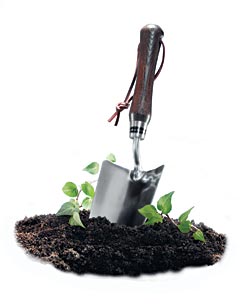The green buds and sprouts of spring are popping out everywhere, each one an invitation to head outside. It’s the season of optimism, the time of year when everyone’s a gardener and every garden is a playground. Bald spots (and there will be some, due to last year’s drought) are just opportunities to try something new. So take your cue from the plants that stuck around, and flourish in the warmth of spring. Here are 11 ways to do it.
|
Photograph: Leonard Gertz
 |
Take a look underfoot
Maybe this is the year to replace those bland concrete walks with brick, or that weedy lawn with new sod. Improving the look of garden surfaces "will create stronger visual contrasts, strengthen your garden’s outlines, and provide an instant upgrade," says Scott Mehaffey, design department manager at Craig Bergmann Landscape Design in Wilmette. Warning: Just as a new rug might make your old furniture look shabby or dated, Mehaffey notes, new sod and walks could highlight the need for other garden improvements.
Feed the world
Well-aged compost is a superior meal for virtually all garden plants, as well as for your lawn. If you’re not composting at home, you can buy bagged compost at any garden center. Lay a nice, even half-inch blanket over all your planting beds as a spring topdressing, and you’ll see fewer weeds and more lush plant growth all summer.
Get bamboozled
"The hottest plant for 2006 is going to be bamboo," says Tara Heibel, owner of Sprout Home, the edgy garden and housewares shop in Ukrainian Village. In a container or in the ground, bamboo is stylishly tropical and makes a great privacy screen. Sprout Home’s garden manager, Jill Nelson, says one of the best varieties for Chicago is Fargesia rufa, which is wind- and frost-tolerant, thrives in sun or shade, and grows to eight feet tall. Plus, it’s a clumping bamboo, not a runner, so it won’t colonize every inch of your garden.
Bring it in
Blooming trees and shrubs are some of the season’s dazzlers. Armloads of flowering quince, crabapple, witch hazel, or forsythia branches bring a breath of spring indoors. And if you just can’t wait, branches with buds (if your shrub has any to spare) can be "forced" to blossom early by putting them inside in a water-filled vase.
Bushwhack
Most shrubs re-quire occasional pruning if they are to bloom at their best and not get shaggy. The Morton Arboretum’s Jan Little advises any homeowner who doesn’t know how to prune properly to take a class or study a book that diagrams the process, and then approach the task carefully. The key is timing; in general, shrubs that bloom in the spring should be pruned after flowering, but there are exceptions. Consult the plant help lines at the arboretum (630-719-2424) or the Chicago Botanic Garden (847-835-5440, ext. 2), or research your shrub in a good plant encyclopedia before getting out the trimmers.
Get some perspective
From a rooftop, balcony, or upstairs window, get a bird’s-eye view of how your garden is-or isn’t-laid out, Mehaffey suggests. It’s a great planning technique that gives you the perspective a designer would have when sketching out a new garden. You’ll get a sense of the overall geometry of your layout and see more clearly where paths ought to go, where the edges of plant beds should be sharper, and where you might like to make big changes.
Enter the stone age
Rocks aren’t only what you dig up to make room for plants to grow; they can also function as sculptural accents, objects of permanence in a seasonally changing landscape. Besides, "they’re easy to take care of," Nelson says. Solitary boulders bring a Zen feel to a garden, while a long, winding vein of sleek black pebbles creates the illusion of a stream.
Divide and conquer
Divide all but the earliest-blooming perennials in the spring-most perennials can take it. The ones that really need dividing are those with an outer ring of active growth and a hollow center. It’s easy. Using a sharp-edged spade, pry the root mass up out of the ground. Hack the thing right down the middle with the same tool and replant one half in the original hole. "Give the other one to a gardening friend," Little says.
Party on
Mehaffey knows how overwhelming garden chores can seem in the spring. His solution: "Entertain! A party creates a deadline for getting things done." It also guarantees that you won’t get so caught up in garden work that you miss your chance to enjoy a sunny afternoon with your friends before it gets too hot out.
Pull up a chair
For a short time every year, we can pretend we live in Tuscany, where al fresco dining is a tradition. "Add a furniture setting to your garden, and make sure your grill is cleaned up and ready for entertaining," says Jennifer Brennan, horticulture information specialist at Wilmette’s Chalet Nursery. "That southern European influence is a big thing, so be ready for it."
Just stop
"Enjoy the daily changes," Little says. "Spring is our most changeable season. Spend some time noticing the changes in the direction and intensity of light, the unfolding of foliage, flowers emerging and blooming. There’s a lot to enjoy if you stand still and look."



